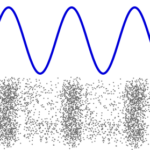What Are Sound Waves?
Sound is all around us and is how we hear things like music, voices, and footsteps.
The science of sound waves is called acoustics, the study of mechanical waves in solids, liquids, and gases.
How do sound waves travel?
Sound waves are vibrations that travel through a medium (like air, water, or solids) and can be heard when they reach our ears.
- When something makes a sound, it creates vibrations that push against the air particles around it.
- These vibrations travel outward as a wave.
- Sound waves travel faster through solids and liquids than through gases because the particles in solids and liquids are closer together.
Properties Of Sound Waves
The properties of sound waves help us understand how sound waves travel, how we perceive different sounds, and how various factors can affect sound in our environment.
- Wavelength: The wavelength is the distance between two peaks or troughs in a sound wave and determines the pitch. Longer wavelengths create lower pitches, and shorter wavelengths produce higher pitches.
- Frequency: The number of sound wave cycles that pass a point per second, measured in Hertz (Hz). Higher frequencies produce higher-pitched sounds.
- Amplitude: The height of the sound wave’s peaks, which determines the volume or loudness of the sound. Larger amplitudes produce louder sounds.
- Speed: The rate at which sound waves travel through a medium. For example, sound travels faster in water than in air.
- Frequency Range: The range of frequencies the human ear can hear is typically from about 20 Hz to 20,000 Hz. Sounds outside this range are either infrasonic (below 20 Hz) or ultrasonic (above 20,000 Hz).
- Reflection: The bouncing back of sound waves when they hit a surface can create echoes.
- Refraction: The bending of sound waves as they pass from one medium to another with different densities can change the direction of sound and affect how it is heard.
Practical Applications Of Sound Waves
- Navigation: Sonar uses sound waves to help submarines navigate underwater, and to track ships, aircraft, and missiles.
- Medical imaging: Ultrasound machines use high-frequency sound waves to create images of the inside of the body, helping doctors diagnose and monitor conditions.
- Communication: Telephones, radios, and microphones use sound waves to transmit and receive information, allowing us to communicate over distances.
- Noise-Canceling Technology: Noise-canceling headphones use sound waves to create interference patterns that cancel out unwanted background noise, providing a better listening experience.
Fun Facts
Here are some interesting facts about sound waves:
- Elephants use low-frequency sounds called infrasound that travel long distances through the ground to communicate with each other.
- Sound travels about 343 meters per second in air, but it travels even faster in water, about 1500 meters per second.
- Dolphins and bats use echolocation by emitting sound waves and listening for the echoes to locate objects and prey.
- Space has no sound because sound waves need a medium (like air or water) to travel through, and space is a vacuum.
Review
Let’s quickly recap what we learned about sound waves:
- What determines the pitch of a sound? Frequency
- What is the height of a sound wave’s peaks that affects volume? Amplitude
- What is the distance between two consecutive peaks in a sound wave called? Wavelength
- What range of frequencies can the human ear typically hear? 20 Hertz to 20,000 Hertz


Recent Comments